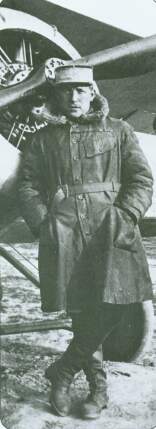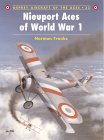Charles Nungesser
Flamboyant French Ace of WWI, 43 victories
By Stephen Sherman, Aug. 2001. Updated April 15, 2012.
A fractured skull, two broken legs, a smashed arm, a multiple-fractured jaw, a scorched foot, and a burned hand - these were some of the seventeen injuries that Charles Nungesser suffered while flying for France in the First World War. A dashing, devil-may-care pilot of legend, he was reputed to have spent more time in the hospital and in various women's beds than he did in the air. And he spent enough time in the air to shoot down 43 (45?) German aircraft.
Despite his many injuries, he survived the war, and in 1927 attempted to be the first to fly the Atlantic.
Background
Born in 1892, Charles Eugene Jules Marie Nungesser was an athlete from an early age: he practiced boxing, swimming, cycling, and soccer. A thrill-seeker, his youthful ambitions were to be a airplane pilot or a race-car driver. By the age of sixteen, he had left Paris for Buenos Aires, where he had the opportunity to race automobiles and to learn to fly.
With the threat of war in 1914, Nungesser was back in Europe, volunteering for service in France's Aviation Militaire, but he had to settle for the cavalry, the Second Hussars. He was decorated during the Battle of the Marne, for leading a daring attack on a German staff car, killing (capturing?) five Boche officers and capturing the vehicle. He leveraged this exploit into a transfer to the air service in November, 1914.
March, 1915
He was made a pilot in March, 1915 at Avord, and was assigned to Escadrille Voisin 106. Foreshadowing his later career, he frequently brought his Voisin (type 3?) biplane back to base riddled with bullet holes. In April, he recklessly attacked an Albatros; the German carried a Parabellum machine gun, while Nungesser's observer, Pichon, was only equipped with a rifle. The Albatros led them over an anti-aircraft battery; its shrapnel tore into the Voisin and knocked out its engine. Nungesser glided the plane back inside the French lines and made a dead-stick, crash landing. Next, he crashed a Morane and put himself in bed for a month with various broken bones.
At a new airfield at Nancy, he found a brand-new Voisin light bomber (type 4?), equipped with a Hotchkiss machine gun and took it up without authorization. When four German planes came over, Nungesser's CO could not find him; he was busy, in the air, shooting down an Albatros. For this, he received both eight days' arrest and the Croix de Guerre. Apparently the women of Nancy also expressed their gratitude to him.
In January, 1916, his leg was injured so badly that he needed a cane thereafter; evidently this injury did not impair his social nor his flying activities. Like his body, his aircraft was usually a patched-up mess, and after any battle, was likely to be worse off. Both he and his planes were constantly bandaged and re-built. But internally, he seemed more resilient than many other aces; his nerves were fine. He never had the shakes and never threw up his breakfast.
May, 1916
He won assignment to a fighter squadron, Escadrille N. (Nieuport) 65. With black humor he decorated the fuselage of his Nieuport 11 with a skull, crossed bones, a coffin, and candles. Then he went out and downed a German observation balloon. Repeated stunting led to more reprimands and house arrest. But when he downed an Albatros he was awarded the Légion d'Honneur.
Rumor had it that Nungesser was intimate with Mata Hari, the famous spy. Aware of her espionage, he amused himself by regaling her with fanciful tales of a new French "super-plane," powered by eight big new (also secret) engines. He spent his leaves in Paris, with Colette's courtesans, in the brothels near the Ritz, and at the bars with American pilots.
One of Nungesser's drinking buddies was Jean Navarre, another flamboyant ace. The two of them almost created the image of fighter pilots as handsome, reckless, hard-living, womanizing rakes. They disliked military discipline and enjoyed Paris' many attractions as often as possible. Nungesser was known to show up for a morning patrol in a tuxedo, perhaps with his woman still on his arm. Once, Nungesser was driving into Paris, amidst heavy traffic, when he spotted his own aircraft heading that way. It was Navarre! He had borrowed Nungesser's airplane; he explained that his own had been shot up and that he "had forgotten what a woman looked like."
Charles Nungesser ran up his score to ten by mid-June of 1916, an outstanding number at that time. Flying over Forges late in the month, he knocked down an L.V.G.
His favorite maneuver was the whip stall. He would get above his oppenent and dive down sharply, gaining terrific speed. Then, he would pull out the dive from somewhat below the enemy, and pull up, firing a burst into the plane's belly. When he could thus deliver a fatal blow, it worked fine. But if not, he had no choice but to stall at the top of the zoom; with little airspeed, he was highly exposed. In part this tactic contributed to his frequent injuries.
December, 1916
He had claimed 20 aerial victories by December, 1916. On the 19th, his carelessness almost caught up with him. His aircraft had just been completely overhauled when he took it up for a test flight. Over Chaulnes Wood, he spotted an L.V.G. and went after it, with one of his usual whip stalls. But when he reached the top of his arc, he discovered that there was no Lewis gun on the upper wing. It had been removed during the repair. His only choice was to threaten to ram the German's tail. This worked and the L.V.G. was forced down on the French side. Nungesser had his 21st victory.
Not long after this stunt, he was injured again, and sidelined for three months.
April, 1917
When he returned to combat flying, he was allowed to free-lance. He could fly anywhere, with any escadrille, to go after German airplanes.
His black-and-white skull-and-crossbones insignia were well-known on both sides. One day (or so the story goes) a German plane dropped a challenge at his aerodrome, "TO MY WORTHY OPPONENT, MONSIEUR SKULL AND BONES. MEET ME AT FOUR O'CLOCK." Warned that this was a trap, Nungesser still could not resist. He checked out his Nieuport carefully, and went up at 2:30. Allegedly he used by fuel and ammunition strafing a German airfield before he arrived at the appointed time and place. And of course, when he did, six Hun Albatroses jumped him. And with daring and astonishing maneuvers, he shot down two of them, scaring the rest away. (This is the story I read in one of the secondary sources; to me, it sounds too cinematic to be true. But of course, I wasn't there. - SS)
On another day a British-marked aircraft attacked him. Thinking this was a German ruse, he fought back and shot down his assailant. It turned out to be a novice English flier, who had mistaken Nungesser's black-and-white skull-and-crossbones for a German insignia. Nungesser repainted his plane in bold red, white, and blue stripes.
From May to August, 1917, he built up his score of aerial victories to thirty-nine. His injuries continued; by this time, he was in constant pain and every kick of the rudder hurt. He had to be carried in and out of his aircraft.
August, 1917
On August 14, he shot down three enemy kite balloons. A week later five Fokkers jumped him and injured him seriously. After seventeen injuries and forty-three (some sources say 45) aerial victories, Charles Nungesser was finally out of the war.
The Translantic Challenge
Still flamboyant and hard-living, he continued flying after the war, also speaking and making movies. In 1927, he was attracted by the Orteig prize, $25,000 offered by a New York hotelier for the first non-stop flight between New York and Paris. Nungesser partnered with Captain François Coli; they outfitted a Levasseur P.L.8, named Le Oiseu Blanc, the White Bird. They took off a week before Lindbergh and were never heard from again. Nungesser' luck finally ran out; he had defeated scores of German fighter pilots, but he was brought down by the vast Atlantic.
Sources:
- The Aerodrome
- Heroes of the Sunlit Sky, by Arch Whitehouse, Doubleday, 1967
- The Canvas Falcons, by Stephen Longstreet, Barnes & Noble, 1970
- Knights of the Air, by Ezra Bowen, Time-Life Books, 1980
- Rand McNally Encyclopedia of Military Aircraft: 1914-1980, by Enzio Angelucci, The Military Press, 1983


